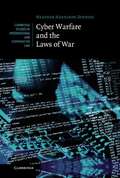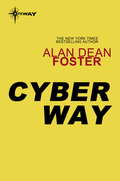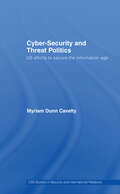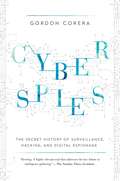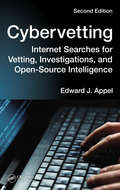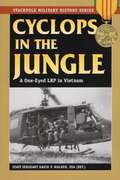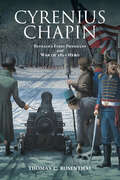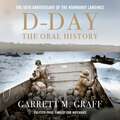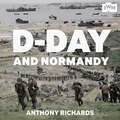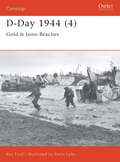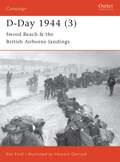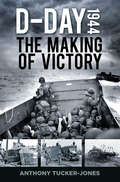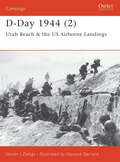- Table View
- List View
Cyber War: The Next Threat to National Security and What to Do About It
by Richard A. Clarke Robert KnakeRichard A. Clarke warned America once before about the havoc terrorism would wreak on our national security--and he was right. Now he warns us of another threat, silent but equally dangerous. Cyber War is a powerful book about technology, government, and military strategy; about criminals, spies, soldiers, and hackers. This is the first book about the war of the future--cyber war--and a convincing argument that we may already be in peril of losing it. Cyber War goes behind the "geek talk" of hackers and computer scientists to explain clearly and convincingly what cyber war is, how cyber weapons work, and how vulnerable we are as a nation and as individuals to the vast and looming web of cyber criminals. From the first cyber crisis meeting in the White House a decade ago to the boardrooms of Silicon Valley and the electrical tunnels under Manhattan, Clarke and coauthor Robert K. Knake trace the rise of the cyber age and profile the unlikely characters and places at the epicenter of the battlefield. They recount the foreign cyber spies who hacked into the office of the Secretary of Defense, the control systems for U.S. electric power grids, and the plans to protect America's latest fighter aircraft. Economically and militarily, Clarke and Knake argue, what we've already lost in the new millennium's cyber battles is tantamount to the Soviet and Chinese theft of our nuclear bomb secrets in the 1940s and 1950s. The possibilities of what we stand to lose in an all-out cyber war--our individual and national security among them-- are just as chilling. Powerful and convincing, Cyber War begins the critical debate about the next great threat to national security.
Cyber Warfare and the Laws of War
by Heather Harrison DinnissThe information revolution has transformed both modern societies and the way in which they conduct warfare. Cyber Warfare and the Laws of War analyses the status of computer network attacks in international law and examines their treatment under the laws of armed conflict. The first part of the book deals with the resort to force by states and discusses the threshold issues of force and armed attack by examining the permitted responses against such attacks. The second part offers a comprehensive analysis of the applicability of international humanitarian law to computer network attacks. By examining the legal framework regulating these attacks, Heather Harrison Dinniss addresses the issues associated with this method of attack in terms of the current law and explores the underlying debates which are shaping the modern laws applicable in armed conflict.
Cyber Way
by Alan Dean FosterHomicide - or cosmic catastrophe?Detective Vernon Moody is a modern cop who likes to catch killers the modern way - with computer webs, databases and common sense.So he's not happy when his latest case revolves around the supposedly mystical properties of a lost Navaho sandpainting. Or when the painting leads him to suspect an alien presence in his modern world.No Moody's getting scared and what started out as a routine murder investigation may uncover the very nature of reality - or destroy it forever!
Cyber-Conflict and Global Politics (Contemporary Security Studies)
by Athina KaratzogianniThis volume examines theoretical and empirical issues relating to cyberconflict and its implications for global security and politics. Taking a multidimensional approach to current debates in internet politics, the book comprises essays by leading experts from across the world. The volume includes a comprehensive introduction to current debates in the field and their ramifications for global politics, and follows this with empirical case studies. These include cyberconflict, cyberwars, information warfare and hacktivism, in contexts such as Sri Lanka, Lebanon and Estonia, the European Social Forum, feminist cybercrusades and the use of the internet as a weapon by ethnoreligious and socio-political movements. The volume presents the theoretical debates and case studies of cyberconflict in a coherent, progressive and truly multidisciplinary way. The book will be of interest to students of cyberconflict, internet politics, security studies and IR in general.
Cyber-Security and Threat Politics: US Efforts to Secure the Information Age (CSS Studies in Security and International Relations)
by Myriam Dunn CaveltyThis book explores the political process behind the construction of cyber-threats as one of the quintessential security threats of modern times in the US. Myriam Dunn Cavelty posits that cyber-threats are definable by their unsubstantiated nature. Despite this, they have been propelled to the forefront of the political agenda. Using an innovative theoretical approach, this book examines how, under what conditions, by whom, for what reasons, and with what impact cyber-threats have been moved on to the political agenda. In particular, it analyses how governments have used threat frames, specific interpretive schemata about what counts as a threat or risk and how to respond to this threat. By approaching this subject from a security studies angle, this book closes a gap between practical and theoretical academic approaches. It also contributes to the more general debate about changing practices of national security and their implications for the international community.
Cyberdeterrence and Cyberwar
by Martin C. LibickiCyberspace, where information--and hence serious value--is stored and manipulated, is a tempting target. An attacker could be a person, group, or state and may disrupt or corrupt the systems from which cyberspace is built. When states are involved, it is tempting to compare fights to warfare, but there are important differences. The author addresses these differences and ways the United States protect itself in the face of attack.
Cyberspies: The Secret History of Surveillance, Hacking, and Digital Espionage
by Gordon CoreraThe previously untold--and previously highly classified--story of the conflux of espionage and technology, with a compelling narrative rich with astonishing revelations taking readers from World War II to the internet age. As the digital era become increasingly pervasive, the intertwining forces of computers and espionage are reshaping the entire world; what was once the preserve of a few intelligence agencies now affects us all. Corera's compelling narrative takes us from the Second World War through the Cold War and the birth of the internet to the present era of hackers and surveillance. The book is rich with historical detail and characters, as well as astonishing revelations about espionage carried out in recent times by the UK, US, and China. Using unique access to the National Security Agency, GCHQ, Chinese officials, and senior executives from some of the most powerful global technology companies, Gordon Corera has gathered compelling stories from heads of state, hackers and spies of all stripes. Cyberspies is a ground-breaking exploration of the new space in which the worlds of espionage, diplomacy, international business, science, and technology collide.
Cyberstrike: London (The Ben Morgan Thrillers)
by James Barrington Prof. Richard BenhamThe start of a major new series from a bestselling thriller writer and a renowned cybersecurity expert.7/7/2005: Ben Morgan, a cybersecurity specialist with the Metropolitan police, starts another day at work. It will be the last normal day he ever has.The Present: In Hong Kong, a crime overlord is offered a deal by shadowy agents from Beijing: his life for a new kind of operation in London. Morgan, now a part of an off the books cyber-terrorism prevention unit, must do everything possible to stop its spread.This is a new kind of war: different goals, tactics, rules, stakes. And Morgan is caught right in the centre...A pulse-pounding thriller rooted in reality, perfect for fans of Frederick Forsyth, Andy McNab and James Deegan.
Cybervetting: Internet Searches for Vetting, Investigations, and Open-Source Intelligence, Second Edition
by Edward J. AppelResearching an individual‘s, firm‘s or brands online presence has become standard practice for many employers, investigators, and intelligence officers, including law enforcement. Countless companies and organizations are implementing their own policies, procedures, and practices for Internet investigations, cybervetting, and intelligence.
Cyberwar and Revolution: Digital Subterfuge in Global Capitalism
by Svitlana Matviyenko Nick Dyer-WithefordUncovering the class conflicts, geopolitical dynamics, and aggressive capitalism propelling the militarization of the internet Global surveillance, computational propaganda, online espionage, virtual recruiting, massive data breaches, hacked nuclear centrifuges and power grids—concerns about cyberwar have been mounting, rising to a fever pitch after the alleged Russian hacking of the U.S. presidential election and the Cambridge Analytica scandal. Although cyberwar is widely discussed, few accounts undertake a deep, critical view of its roots and consequences. Analyzing the new militarization of the internet, Cyberwar and Revolution argues that digital warfare is not a bug in the logic of global capitalism but rather a feature of its chaotic, disorderly unconscious. Urgently confronting the concept of cyberwar through the lens of both Marxist critical theory and psychoanalysis, Nick Dyer-Witheford and Svitlana Matviyenko provide a wide-ranging examination of the class conflicts and geopolitical dynamics propelling war across digital networks.Investigating the subjectivities that cyberwar mobilizes, exploits, and bewilders, and revealing how it permeates the fabric of everyday life and implicates us all in its design, this book also highlights the critical importance of the emergent resistance to this digital militarism—hacktivism, digital worker dissent, and off-the-grid activism—for effecting different, better futures.
Cyberwars in the Middle East (War Culture)
by Ahmed Al-RawiCyberwars in the Middle East argues that hacking is a form of online political disruption whose influence flows vertically in two directions (top-bottom or bottom-up) or horizontally. These hacking activities are performed along three political dimensions: international, regional, and local. Author Ahmed Al-Rawi argues that political hacking is an aggressive and militant form of public communication employed by tech-savvy individuals, regardless of their affiliations, in order to influence politics and policies. Kenneth Waltz’s structural realism theory is linked to this argument as it provides a relevant framework to explain why nation-states employ cyber tools against each other. On the one hand, nation-states as well as their affiliated hacking groups like cyber warriors employ hacking as offensive and defensive tools in connection to the cyber activity or inactivity of other nation-states, such as the role of Russian Trolls disseminating disinformation on social media during the US 2016 presidential election. This is regarded as a horizontal flow of political disruption. Sometimes, nation-states, like the UAE, Saudi Arabia, and Bahrain, use hacking and surveillance tactics as a vertical flow (top-bottom) form of online political disruption by targeting their own citizens due to their oppositional or activists’ political views. On the other hand, regular hackers who are often politically independent practice a form of bottom-top political disruption to address issues related to the internal politics of their respective nation-states such as the case of a number of Iraqi, Saudi, and Algerian hackers. In some cases, other hackers target ordinary citizens to express opposition to their political or ideological views which is regarded as a horizontal form of online political disruption. This book is the first of its kind to shine a light on many ways that governments and hackers are perpetrating cyber attacks in the Middle East and beyond, and to show the ripple effect of these attacks.
Cyclops In The Jungle: A One-eyed Lrp In Vietnam
by David P. WalkerDave Walker enlisted in the U.S. Army at seventeen, full of patriotism and eager to play his part in Vietnam. Trained for long-range patrol (LRP) operations, he received a debilitating shrapnel wound to his eye barely a month after arriving in Vietnam. Medically discharged and sent home to a country he decreasingly recognised, Walker, now missing an eye, manoeuvred his way back to the jungles of Vietnam, where he survived another eighteen months conducting patrols and special operations with an elite Ranger unit.
Cynthia Ann Parker
by Grace JacksonCynthia Ann Parker, first published in 1959, is a fascinating account of the life of a girl of European descent, who at the age of about ten, was captured (along with her brother) in Texas by raiding Comanche. Cynthia would then grow up with her captors and live among the Comanche for the next 24 years. Parker was recaptured during the Battle of Pease River in 1860 and would spend the remaining 11 years with various members of her birth family. During her time with the Comanche, she married Peta Nocona, a chieftain, and had three children with him, including Quanah Parker, the last free Comanche chief. Cynthia Ann Parker never adjusted to the ways of the white man, and made at least one attempt to escape and return to her tribe. Included are 13 pages of photographs and a number of pen and ink drawings.
Cyprus
by Christopher HitchensDiscussion of the conflicts involving Greece, Turkey, and Cyprus and the effects of this conflict on the rest of the world.
Cyprus and its Regiment in the Second World War
by Marios SiammasThis book explores the role of the Cyprus regiment, a military unit of the British Army, in the Second World War. Highlighting the contribution of Cyprus to the war effort, the book contributes to the limited historiography on the military engagement of Cyprus in the Second World War. Through an analysis of British official records and interviews the author aims to provide the required chronological and contextual placement of events involving Cyprus and the Cyprus Regiment. By drawing upon veterans’ narratives and operational insights, the book offers a personal view and assessment of the Second World War period. The book covers a number of themes, including the recruitment of Cypriots to the British Army and the training they received, the establishment of the Cyprus Volunteer Force, the experiences of Cypriot soldiers while serving in multiple countries, and the wider impact of the war on Cyprus, economically, socially and militarily.
Cyrenius Chapin: Buffalo’s First Physician and War of 1812 Hero (Excelsior Editions)
by Thomas C. RosenthalAmerica's geographic and ideological frontier as lived by Buffalo's first physician, renegade militia officer, and founding citizen.Cyrenius Chapin tells the story of life in the young American republic through the experiences of a local physician, land speculator, and patriotic citizen. Chapin arrived in Buffalo in 1803 blessed with a forceful personality, infuriating gall, and a caring nature. He became a leader in the growing community, tending to its sick, training its future doctors, and engaging in local politics. A determined Federalist, he challenged Joseph Ellicott of the Holland Land Company, raised a family, and was a personal friend of Native American leaders. During the War of 1812, Dr. Chapin single-handedly resisted the British advance on the city but ultimately failed to prevent Buffalo's burning by the royalist forces. Pneumonia struck him down in 1838 following his third attempt to drive the British out of upper Canada. Extensively researched, this is the story about the age of revolution and a time when American independence and self-determination were inseparable.
D-DAY The Oral History: The Turning Point of WWII By the People Who Were There
by Garrett M. GraffA LANDMARK NEW ACCOUNT OF THE SINGLE MOST IMPORTANT DAY OF WW2, IN THE WORDS OF THE PEOPLE WHO LIVED IT'A sprawling history of D-Day from the point of view of participants on both sides.' -Kirkus'A masterpiece of oral history. Stirring, surprising, grim, joyous, moving and always riveting.' -Evan ThomasOn 6th June 1944, the Allied invasion began. For hours, wave after wave of soldiers, sailors, and airmen crossed the channel and stormed the Normandy coast, fighting to gain a foothold in Nazi-occupied Northwest Europe. It was the largest combined air and seaborne invasion ever, involving over 150,000 Allied troops on the ground, and its eventual success became a critical turning point in the war, spelling the beginning of the end for the Third Reich.As the events of that day fade from living memory, it's more important than ever to understand what it felt like to be there and to live through it, on both sides. In this definitive work, Garrett M. Graff, the bestselling author of The Only Plane in the Sky: The Oral History of 9/11, compiles over 600 US, Canadian, UK, French and German voices to tell the full story of exactly how that historic day unfolded, in visceral detail - as well as the weeks and months leading up to it. From paratroopers to fighter pilots to nurses, generals, French villagers, German Defenders to Winston Churchill and Franklin Roosevelt, this is the most intimate re-telling of D-Day published to date. Praise for THE ONLY PLANE IN THE SKY: "The most moving and chilling oral history you will read." The Times"Incredibly evocative and compelling." The Washington Post"A hugely powerful new book." Dan Snow"Astonishing book about an astonishing, terrifying atrocity, relived in real time by those who were there. I read it in one sitting & was utterly gripped from start to finish." Piers Morgan
D-DAY The Oral History: The Turning Point of WWII By the People Who Were There
by Garrett M. GraffA LANDMARK NEW ACCOUNT OF THE SINGLE MOST IMPORTANT DAY OF WW2, IN THE WORDS OF THE PEOPLE WHO LIVED IT'A sprawling history of D-Day from the point of view of participants on both sides.' -Kirkus'A masterpiece of oral history. Stirring, surprising, grim, joyous, moving and always riveting.' -Evan ThomasOn 6th June 1944, the Allied invasion began. For hours, wave after wave of soldiers, sailors, and airmen crossed the channel and stormed the Normandy coast, fighting to gain a foothold in Nazi-occupied Northwest Europe. It was the largest combined air and seaborne invasion ever, involving over 150,000 Allied troops on the ground, and its eventual success became a critical turning point in the war, spelling the beginning of the end for the Third Reich.As the events of that day fade from living memory, it's more important than ever to understand what it felt like to be there and to live through it, on both sides. In this definitive work, Garrett M. Graff, the bestselling author of The Only Plane in the Sky: The Oral History of 9/11, compiles over 600 US, Canadian, UK, French and German voices to tell the full story of exactly how that historic day unfolded, in visceral detail - as well as the weeks and months leading up to it. From paratroopers to fighter pilots to nurses, generals, French villagers, German Defenders to Winston Churchill and Franklin Roosevelt, this is the most intimate re-telling of D-Day published to date. Praise for THE ONLY PLANE IN THE SKY: "The most moving and chilling oral history you will read." The Times"Incredibly evocative and compelling." The Washington Post"A hugely powerful new book." Dan Snow"Astonishing book about an astonishing, terrifying atrocity, relived in real time by those who were there. I read it in one sitting & was utterly gripped from start to finish." Piers Morgan
D-Day & Normandy
by Anthony RichardsIn the hours before dawn on June 6, 1944, an unprecedented assemblage of men, weapons, and machines swung into action. The long-awaited, highly secret D-Day invasion had begun. By the end of the day, the mission to liberate Europe would have made its most crucial advance.This book marks the seventy-fifth anniversary of D-Day through a rich account of the invasion and its aftermath. Drawing on the unparalleled collections of IWM, it reconstructs the historic landings and the subsequent battle for a foothold in Normandy. Interviews and firsthand accounts put the reader right into the action, reminding us that even with all the careful planning and firepower the Allies were able to muster, the outcome of the invasion was far from certain. Re-creating the drama and danger of D-Day, this book will be the perfect commemoration of a day that truly changed the world.(P)2020 Headline Publishing Group Limited
D-Day (Cornerstones of Freedom, 2nd Series)
by Tom McgowenThe island of Britain is separated from continental Europe by a stretch of sea known as the English Channel. As night closed over Britain on June 5,1944, the roar of airplane engines filled the air. From 190 airfields on the island, bombers, fighter planes, troop transport planes, and were taking off by the thousands to fly across the Channel. The first blow of the greatest invasion in the history of the world was about to be struck!
D-Day 1944 - Air Power Over The Normandy Beaches And Beyond [Illustrated Edition]
by Richard P. HallionIncludes over 12 photos and maps of the Overlord OperationsOperation Overlord, the Normandy invasion-like William the Conqueror's before it or the Inchon landing afterwards-will long be studied as a classic in military planning, logistics, and operations. OVERLORD depended to a remarkable degree upon the use of air power in virtually all its forms. A half-century ago, aircraft were primitive vehicles of war compared to the modern attackers of the Gulf War era, with their precision weapons, advanced navigational, sensor systems, and communications. Yet, the airplane still had a profound impact upon the success of the invasion. Simply stated, without air power, Normandy would have been impossible.
D-Day 1944: Gold and Juno Beaches
by Ken Ford Kevin LylesOperation Overlord, the Allied invasion of Normandy, was the greatest sea-borne military operation in history. At the heart of the invasion and key to its success were the landings of British 50th Division on Gold Beach and Canadian 3rd Division on Juno Beach. Not only did they provide the vital link between the landings of British 3rd Division on Sword Beach and the Americans to the west on Omaha, they would be crucial to the securing of the beachhead and the drive inland to Bayeux and Caen. In the fourth D-Day volume Ken Ford details the assault that began the liberation of Nazi-occupied Europe.
D-Day 1944: Sword Beach and the British Airborne Landings
by Howard Gerrard Ken FordAt 0016hrs on 6 June 1944 a Horsa glider ground to a halt a mere 60 yards from the Orne Canal bridge at Bénouville in Normandy. A small group of British paratroopers burst from it and stormed the bridge within minutes. The Allied liberation of Nazi-occupied Europe had begun. Within a few hours landing craft would swarm towards Ouistreham as British 3rd Division stormed ashore at Sword Beach. The battle would then begin to break through to relieve the paratroopers. In the third of the D-Day volumes Ken Ford details the assault by British 6th Airborne Division and the British landings on Sword Beach that secured the vital left flank of the invasion.From the Trade Paperback edition.
D-Day 1944: The Making of Victory
by Anthony Tucker-JonesD-Day was unprecedented. An invasion of this scale and magnitude had never been carried out before. The landings in North Africa, Sicily and Italy were of limited scope by comparison; if they had failed it would not have been a complete disaster, whereas Normandy heralded the long-awaited Second Front.D-Day 1944: The Making of Victory investigates the great feats of unique problem-solving that enabled the success of such an important invasion. Military historian Anthony Tucker-Jones brings his expert eye to bear on the D-Day landings and subsequent Normandy campaign. He reassesses the technical ingenuity required through the eyes of those who fought there, and vividly reveals how each side managed, whether dealing with the challenges of crossing the Channel safely or in defence of the French coast. Including first-hand accounts, this book places the reader in the thick of the action.
D-Day 1944: Utah Beach & the US Airborne Landings
by Steven Zaloga Howard GerrardThe second title in Osprey's survey of the D-Day landings of World War II (1939-1945). On their western flank, the Allied landings on D-Day combined a parachute drop by the 82nd and 101st Airborne Divisions with an amphibious assault on "Utah" Beach by the US 4th Infantry Division. The landings came ashore in the wrong place but met weaker German resistance as a result. The heaviest fighting took place inland where the badly scattered paratroopers gradually gathered in small groups and made for their objectives. This book traces the story of D-Day on Utah beach, revealing how the infantry pushed inland and linked up with the Airborne troops in a beachhead five miles deep. Now the battle to break out and seize the key port of Cherbourg could begin.

